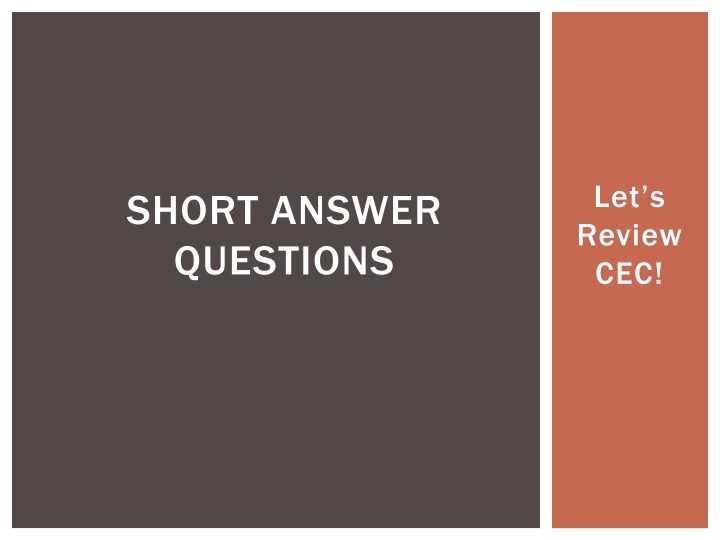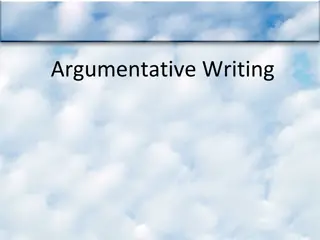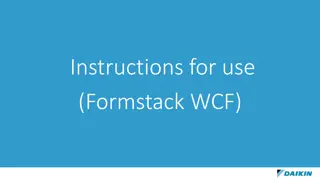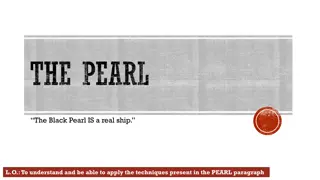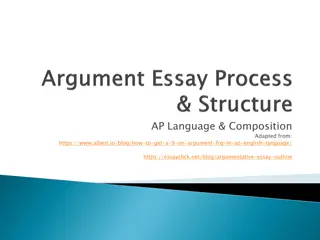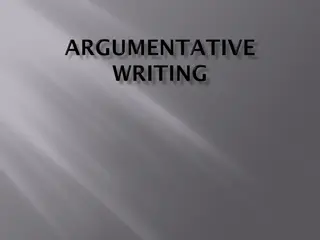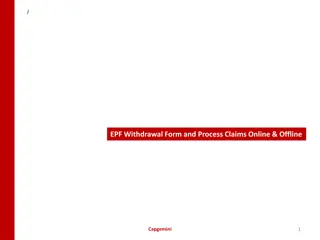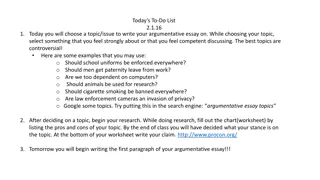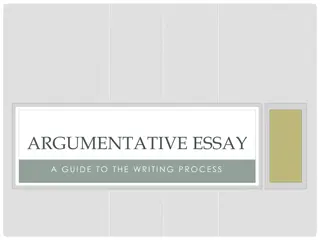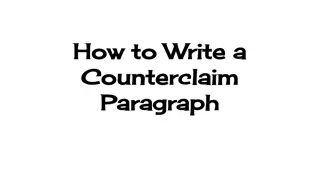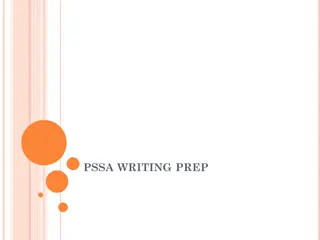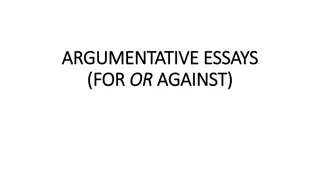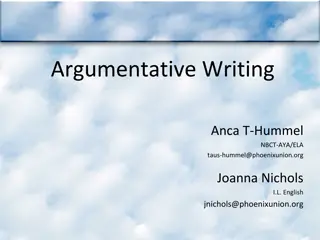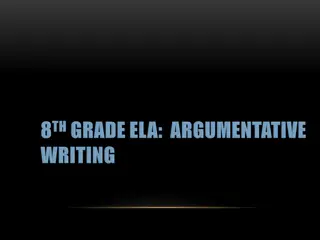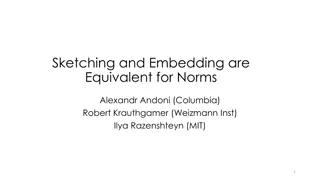Enhancing Argumentative Writing Skills Through Claim, Evidence, and Embedding Techniques
Explore the strategies of making claims, providing evidence, and embedding quotations effectively in argumentative writing. Understand the importance of presenting factual statements, supporting claims with evidence, and integrating quotations seamlessly. Practice crafting strong arguments and refining writing skills in enhancing persuasive communication.
Download Presentation

Please find below an Image/Link to download the presentation.
The content on the website is provided AS IS for your information and personal use only. It may not be sold, licensed, or shared on other websites without obtaining consent from the author.If you encounter any issues during the download, it is possible that the publisher has removed the file from their server.
You are allowed to download the files provided on this website for personal or commercial use, subject to the condition that they are used lawfully. All files are the property of their respective owners.
The content on the website is provided AS IS for your information and personal use only. It may not be sold, licensed, or shared on other websites without obtaining consent from the author.
E N D
Presentation Transcript
Lets Review CEC! SHORT ANSWER QUESTIONS
CLAIM Claim: Claim: Reword the question & answer as a statement of fact. Do not use phrases like: In my opinion I think I believe Do not talk to the reader. I am going to answer the question I think you should agree with me
CLAIM Let s practice making some claims! When you go to the movies, is popcorn better than candy? What is the best kind of music? Why do you think you are required to take English class each year? Should we be allowed to burn the US flag? Should the death penalty be legal?
EVIDENCE Evidence: Prove your claim! Do not use a quote just to finish your sentence. Do not use a quote just to echo what you have already said. Make sure that you embed your quotes. Let s look at the following slides for more information regarding embedding your evidence.
EMBED EVIDENCE Introduce the quotation with a complete Introduce the quotation with a complete sentence and a colon. sentence and a colon. In "Where I Lived, and What I Lived For," Thoreau states directly his purpose for going into the woods: "I went to the woods because I wished to live deliberately " Thoreau ends his essay with a metaphor: "Time is but the stream I go a-fishing in."
EMBED EVIDENCE Use an introductory or explanatory phrase, but Use an introductory or explanatory phrase, but not a complete sentence, separated from the not a complete sentence, separated from the quotation with a comma. quotation with a comma. Thoreau suggests the consequences of making ourselves slaves to progress when he says, "We do not ride on the railroad; it rides upon us." Thoreau asks, "Why should we live with such hurry and waste of life?" According to Thoreau, "We do not ride on the railroad; it rides upon us."
EMBED EVIDENCE Make the quotation a part of your own sentence Make the quotation a part of your own sentence without any punctuation between your own words without any punctuation between your own words and the words you are quoting. and the words you are quoting. Thoreau suggests the consequences of making ourselves slaves to progress when he says that we do not ride on the railroad; it rides upon us." Thoreau argues that "shams and delusions are esteemed for soundest truths, while reality is fabulous." According to Thoreau, people are too often "thrown off the track by every nutshell and mosquito's wing that falls on the rails."
EMBED EVIDENCE Use short quotations Use short quotations-- --only a few words own sentence. own sentence. In "Where I Lived, and What I Lived For," Thoreau states that his retreat to the woods around Walden Pond was motivated by his desire "to live deliberately" and to face only "the essential facts of life." Thoreau argues that people blindly accept "shams and delusions" as the "soundest truths," while regarding reality as "fabulous." Although Thoreau "drink[s] at" the stream of Time, he can "detect how shallow it is." only a few words-- --as part of your as part of your
EMBED EVIDENCE Notice the Punctuation! Notice the Punctuation! Think of the alphabet. L M N O P P Q Q R P comes before Q. Well in most case (we ll discuss the exceptions later in the year), p punctuation comes before q quotation.
COMMENTARY Commentary: Commentary: Explain or expand on your answer. Directly tell your reader how the evidence you have just provided proves your answer. You can begin with phrases such as: This emphasizes , This demonstrates , This signifies that
CEC EXAMPLE Let s imagine that we have just finished reading a story about a young boy who is irritated by having to spend his summer helping take care of his grandfather. By the end of the summer, the young man has learned to appreciate his grandfather. Sample Question: How does the narrator s attitude toward his grandfather change over the course of the summer? Answer the question directly using good word choice and by restating words from the question.
CEC EXAMPLE CLAIM: The narrator s attitude changes toward his grandfather over the course of the summer from being ungrateful to appreciative of his grandfather. Notice that it restates the question using the same words and directly gives an answer to the question.
CEC EXAMPLE EVIDENCE: The narrator says, I hate having to take care of Grandpa at the beginning of the story. When summer is over, he writes in his journal, Grandpa used to be a basketball star! That s so cool that he can teach me! These two sentences provide evidence that directly supports the answer. Notice how well the quotes are embedded into the sentences.
CEC EXAMPLE COMMENTARY: This demonstrates the narrator s attitude change as he learns new aspects of his grandfather s life. By the end of the summer, the narrator realizes that his grandfather is not just a burden; he actually has the ability to affect the narrator s life in a positive way. This sentence explains how the quote supports the answer to better prove the answer.
STUDENT SAMPLES Put in samples of your students CEC writing. Be sure to include at least one of each score. Discuss not only how each could be improved, but also what students did well.
CEC MINOR SUMMATIVE Please read The Giving Tree, by Shel Silverstein. CEC: In the children s book, The Giving Tree, by Shel Silverstein, how would you describe the tree? Remember to: answer the question directly using the same wording from the question. (Claim) give proof from the selection to support your answer. This needs to be an embedded quotation. (Evidence) explain and expand your evidence to support your answer. (Commentary)
